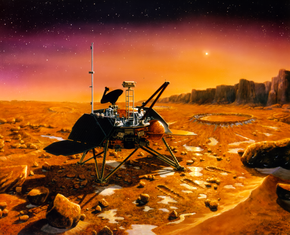 Artist's depiction of the Mars Polar Lander on the Martian surface | |
| Names | Mars Surveyor '98 Lander |
|---|---|
| Mission type | Mars lander |
| Operator | NASA / JPL |
| COSPAR ID | 1999-001A |
| SATCAT no. | 25605 |
| Website | science.nasa.gov |
| Mission duration | 334 days Mission failure |
| Spacecraft properties | |
| Manufacturer | Martin Marietta |
| Launch mass | 583 kg[1] |
| Power | 200 W solar array and NiH2 battery |
| Start of mission | |
| Launch date | 20:21:10, January 3, 1999 (UTC) |
| Rocket | Delta II 7425-9.5 D-265 |
| Launch site | Cape Canaveral Air Force Station SLC-17A |
| Contractor | Boeing |
| End of mission | |
| Disposal | Communication failure after landing |
| Declared | January 17, 2000 |
| Last contact | 20:00, December 3, 1999 (UTC) |
| Mars impact (failed landing) | |
| Impact date | ~20:15 UTC ERT, December 3, 1999 |
| Impact site | Ultimi Scopuli, 76°S 195°W / 76°S 195°W (projected) |
| Mars impactor | |
| Spacecraft component | Deep Space 2 |
 Mars Surveyor 98 mission logo | |
The Mars Polar Lander, also known as the Mars Surveyor '98 Lander, was a 290-kilogram uncrewed spacecraft lander launched by NASA on January 3, 1999, to study the soil and climate of Planum Australe, a region near the south pole on Mars. It formed part of the Mars Surveyor '98 mission. On December 3, 1999, however, after the descent phase was expected to be complete, the lander failed to reestablish communication with Earth. A post-mortem analysis determined the most likely cause of the mishap was premature termination of the engine firing prior to the lander touching the surface, causing it to strike the planet at a high velocity.[2]
The total cost of the Mars Polar Lander was US$165 million. Spacecraft development cost US$110 million, launch was estimated at US$45 million, and mission operations at US$10 million.[3]